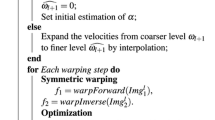Abstract
We propose an algorithm to estimate the motion between two images. This algorithm is based on the nonlinear brightness constancy assumption. The number of unknowns is reduced by considering displacement fields that are piecewise linear with respect to each space variable, and the Jacobian matrix of the cost function to be minimized is assembled rapidly using a finite-element method. Different regularization terms are considered, and a multiscale approach provides fast and efficient convergence properties. Several numerical results of this algorithm on simulated and experimental geophysical flows are presented and discussed.

















Similar content being viewed by others
References
Adrian R (1991) Particle imaging techniques for experimental fluid mechanics. Ann Rev Fluid Mech 23:261–304
Alvarez L, Castaño C, Garcia M, Krissian K, Mazorra L, Salgado A, Sanchez J (2007) A variational approach for 3D motion estimation of incompressible PIV flows, scale space and variational methods in computer vision, vol 15. Springer, Berlin, pp 837–847
Ananden P (1989) A computational framework and an algorithm for the measurement of visual motion. Int J Comput Vis 2:283–310
Arakawa A, Lamb V (1977) Computational design of the basic dynamical processes of the UCLA general circulation model, Methods in Computational Physics, vol 17. Academic Press, London, pp 174–267
Asselin R (1972) Frequency filter for time integrations. Mon Wea Rev 100:487–490
Beauchemin S, Barron J (1995) The computation of optical flow. ACM Comput Surv 27(3):433–467
Black MJ, Anandan P (1993) A framework for the robust estimation of optical flow. In: Proceedings of the Fourth International Conference on Computer Vision, ICCV-93. Berlin, Germany, pp 231–236
Black MJ, Anandan P (1996) The robust estimation of multiple motions: parametric and piecewise-smooth flow fields. Comput Vis Image Underst 63(1):75–104
Blayo E, Durbiano S, Vidard PA, Le Dimet FX (2003) Reduced order strategies for variational data assimilation in oceanic models. Springer, Berlin
Bruhn A, Weickert J, Kohlberger T, Schnörr C (2006) A multigrid platform for real-time motion computation with discontinuity-preserving variational methods. Int J Comput Vis 70(3):257–277
Coriolis (2010) Coriolis rotating platform, website http://www.coriolis-legi.org/
Corpetti T, Mémin E, Pérez P (2002) Dense estimation of fluid flows. IEEE Trans Pattern Anal Mach Intel 24:365–380
Corpetti T, Heitz D, Arroyo G, Mémin E, Santa-Cruz A (2006) Fluid experimental flow estimation based on an optical-flow scheme. Exp Fluid 40(1):80–97
Cuzol A, Hellier P, Mémin E (2007) A low dimensional fluid motion estimator. Int J Comput Vis 75:329–349
Durbiano S (2001) Vecteurs caractéristiques de modèles océaniques pour la réduction d’ordre en assimilation de données. PhD thesis, University of Grenoble
Fehrenbach J, Masmoudi M (2008) A fast algorithm for image registration. C R Acad Sci Paris, Ser I 346:593–598
Fitzpatrick JM (1985) A method for calculating velocity in time dependent images based on the continuity equation. In: Proceedings of Conference Comparative Vision and Pattern Recognition, San Francisco, USA, pp 78–81
Fitzpatrick JM (1988) The existence of geometrical density-image transformations corresponding to object motion. Comput Vis Grap Imag Proc 44:155–174
Flor JB, Eames I (2002) Dynamics of monopolar vortices on the beta plane. J Fluid Mech 456:353–376
Hansen PC (1992) Analysis of discrete ill-posed problems by means of the l-curve. SIAM Rev 34:561–580
Heitz F, Pérez P, Bouthemy P (1994) Multiscale minimization of global energy functions in some visual recovery problems. CVGIP Imag Underst 59(1):125–134
Hellier P, Barillot C, Mémin E, Pérez P (1999) Medical image registration with robust multigrid techniques. In: Proceedings of Second International Conference on Medical Image Computing and Computer-Assisted Intervention, lecture notes in computer science, vol 1679, pp 680–687
Horn B, Schunk B (1981) Determining optical flow. Artif Intell 17:185–203
Huot E, Isambert T, Herlin I, Berroir JP, Korotaev G (2006) Data assimilation of satellite images within an oceanographic circulation model. In: Proceedings of International Conference on Acoustics, Speech, Signal Processing, Toulouse, France
Isambert T, Herlin I, Berroir JP (2007) Fast and stable vector spline method for fluid flow estimation. In: Proceedings of International Conference on Image Processing, San Antonio, USA, pp 505–508
Larsen R, Conradsen K, Ersboll BK (1998) Estimation of dense image flow fields in fluids. IEEE Trans Geosci Remote Sens 36(1):256–264
Lillie RL (1999) Whole earth geophysics: an introduction textbook for gelologists and geophysicists. Prentice Hall, NJ
Lucas B, Kanade T (1981) An iterative image registration technique with an application to stereo vision. In: Proceedings of Seventh International Joint Conference on Artificial Intelligence, Vancouver, Canada, pp 674–679
Ma J, Antoniadis A, Le Dimet FX (2006) Curvlets-based snake for multiscale detection and tracking of geophysical fluids. IEEE Trans Geosci Remote Sens 45(1):3626–3638
Mémin E, Perez P (1998) Optical flow estimation and object-based segmentation with robust techniques. IEEE Trans Imag Proc 7(5):703–719
Mémin E, Pérez P (2002) Hierarchical estimation and segmentation of dense motion fields. Int J Comput Vis 46(2):129–155
Michel Y, Bouttier F (2006) Automatic tracking of dry intrusions on satellite water vapour imagery and model output. Quart J Roy Meteor Soc 132:2257–2276
Papenberg N, Bruhn A, Brox T, Didas S, Weickert J (2006) Highly accurate optic flow computation with theoretically justified warping. Int J Comput Vis 67(2):141–158
Ruhnau P, Kohlberger T, Nobach H, Schnörr C (2005) Variational optical flow estimation for particle image velocimetry. Exp Fluids 38(1):21–32
Tikhonov AN, Arsenin VY (1977) Solution of Ill-posed Problems. Winston & Sons, Washington
Yuan J, Schnörr C, Mémin E (2007) Discrete orthogonal decomposition and variational fluid flow estimation. J Math Imag Vis 28(1):67–80
Acknowledgments
We greatly acknowledge the MOISE research project of INRIA Rhône-Alpes (France) and the Coriolis project of LEGI (Grenoble, France) for providing us the synthetic and real data, respectively. This work is partly done within the MOISE INRIA team and supported by the French National Research Agency (ANR ADDISA). The first author was member of Institut de Mathématiques de Toulouse (Université Paul Sabatier, France) when he contributed to this paper. The authors also thank the referees for their useful comments and perspectives.
Author information
Authors and Affiliations
Corresponding author
Rights and permissions
About this article
Cite this article
Auroux, D., Fehrenbach, J. Identification of velocity fields for geophysical fluids from a sequence of images. Exp Fluids 50, 313–328 (2011). https://doi.org/10.1007/s00348-010-0926-9
Received:
Revised:
Accepted:
Published:
Issue Date:
DOI: https://doi.org/10.1007/s00348-010-0926-9




